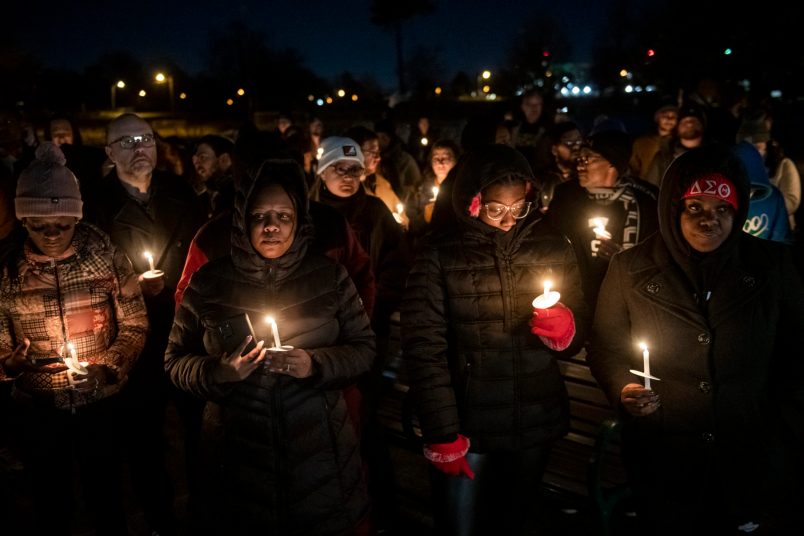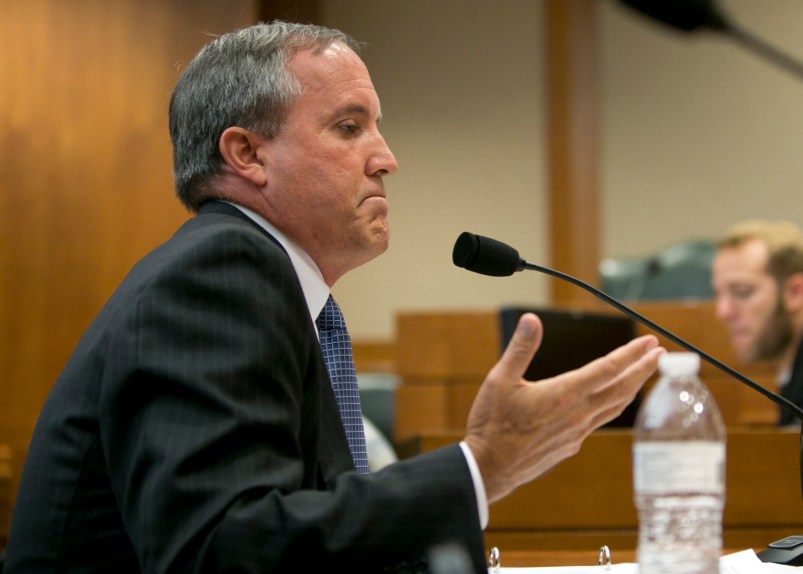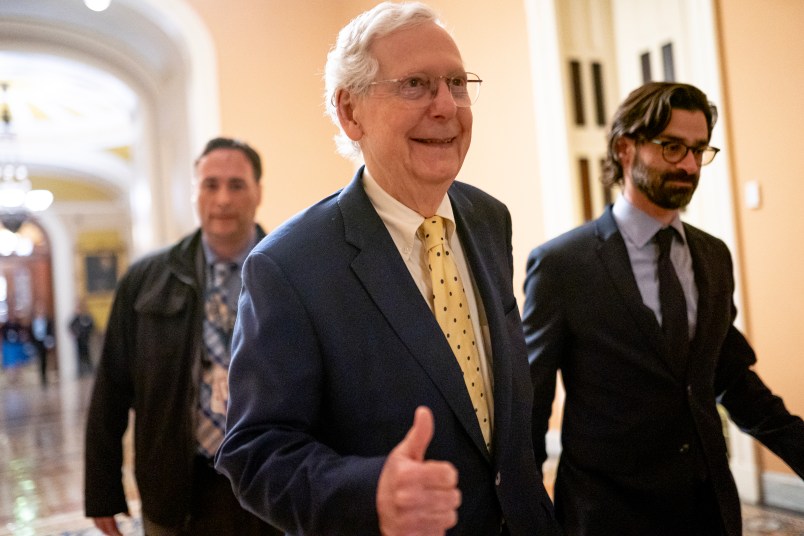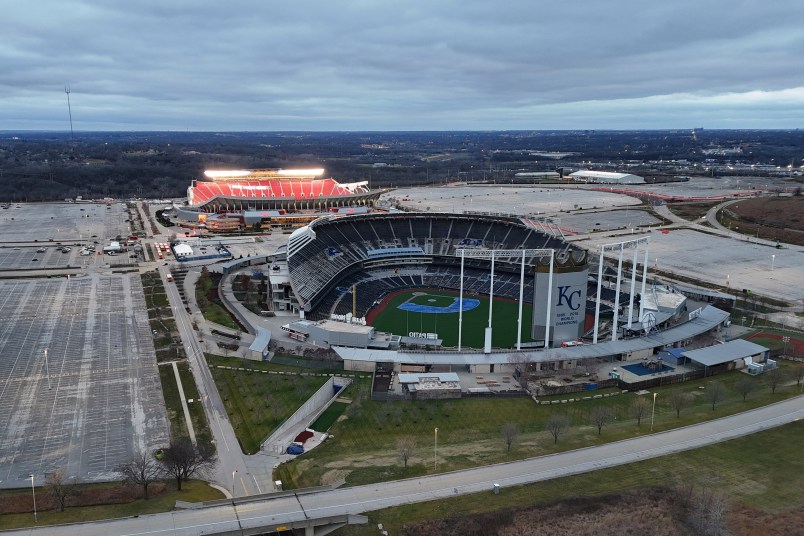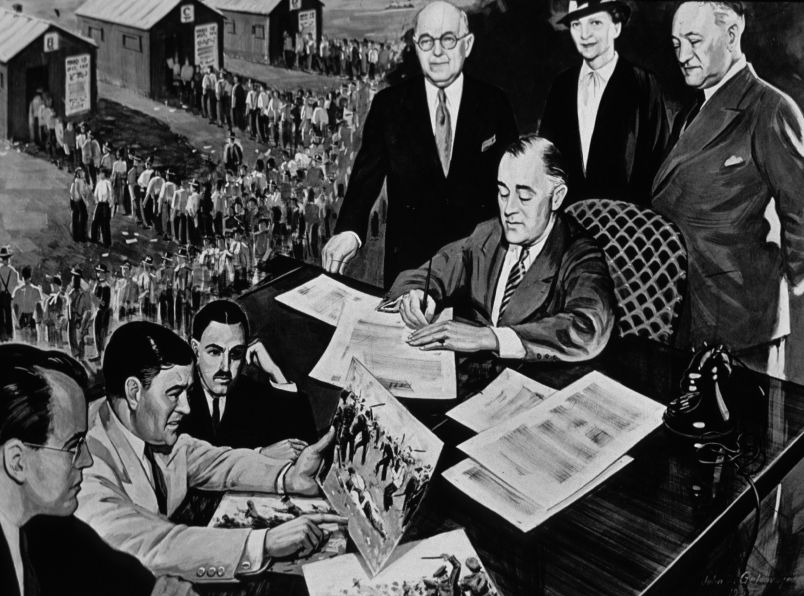This article is part of TPM Cafe, TPM’s home for opinion and news analysis.
The country is now experiencing another wave of outcry and protest in response to the brutal murder of Tyre Nichols, a 29-year-old Black man, by five Memphis police officers. The cops were quickly fired and charged with second-degree murder. The unusually swift action by the police chief and grand jury was facilitated by video footage that clearly showed the cops’ brutal beating of Nichols after they stopped him on suspicion of reckless driving on Jan. 7. He was sent to the hospital in critical condition and died three days later.
A string of highly publicized police murders of Black citizens around the country has prompted news reports of an “epidemic” of police violence against African Americans. But the harsh reality is that there has been no sudden upsurge of racial profiling, arrests, beatings, and killings of African Americans at the hands of law enforcement officers.
Rather than an abrupt recent rise in police mistreatment of Black Americans, we are seeing a surge in awareness of the problem due in part to the use of cameras on police cars and on officers as well as citizen-initiated videos. Because more incidents of police abuse are now being captured on camera, white Americans are waking up to how different Black lives can be.
These videotaped incidents are now part of the political terrain, making it harder for police to hide abusive behavior and easier for community groups to verify longstanding complaints about police misconduct.
What is emerging is a picture of police violence that carries echoes of the often-police-sanctioned lynchings of the Jim Crow era. Those lynchings were frequently caught on camera, too, and those photographs were used both by anti-lynching activists and by white supremacists, who celebrated their vigilante actions.
The fact that the five Memphis officers who killed Nichols are Black reminds us that police, regardless of race, stereotype and fear Black and Brown people, especially young men. This is the result of police culture, not the individual characteristics of particular cops, and reveals what is meant by “systemic racism.”
Nichols joins a growing list of police violence victims whose names have been seared into the national consciousness. These include George Floyd, Sean Bell, Sandra Bland, Alton Sterling, Philando Castile, Michael Brown, Jordan Davis, Amadou Diallo, Eric Garner, Oscar Grant, Freddie Gray, Renisha McBride, Tamir Rice, Walter Scott, Kelley Thomas, and many others.
On top of this growing list are the Black victims of murders by civilians brandishing deadly weapons, including Trayvon Martin, who was killed by George Zimmerman, a self-appointed vigilante in Florida in 2012, and Ahmaud Arbery, who was murdered by Gregory and Travil McMichael, father and son, and a neighbor, William Bryan, while Arbery was jogging in a suburban neighborhood outside Brunswick, Georgia, in 2020.
We know about these police killings in large part because of the exploding use of cell phones cameras, and the emergence, over the last decade and a half, of online infrastructure to host and share the videos that every day Americans record: YouTube, Twitter, Facebook, TikTok. A growing number of police cars are now outfitted with cameras, and in many jurisdictions individual cops now where body cameras.
An early example of brutal police violence captured on video is a famous one: On March 3, 1991, four Los Angeles cops arrested and beat a Black man, Rodney King, after they pulled him over following a high-speed chase. This incident would have been covered up except that a nearby resident, George Holliday, videotaped the beating from his apartment balcony and sent the footage to local news station KTLA. Holliday’s recording was later broadcast around the world, transforming what would have otherwise been an invisible incident into a national, even international, scandal. Thanks to Holliday’s camera, four cops were charged with assault with a deadly weapon and use of excessive force. When the jury acquitted them in April 1992, Los Angeles’ Black and Latino communities erupted in protest, triggering an uprising in which 53 people were killed and over 2,000 were injured. The use of Holliday’s video camera in exposing LAPD racism foreshadowed the more recent practice of ordinary citizens filming police activities on their cell phones.
The 2014 death of Eric Garner, a 43-year-old Black man arrested in New York City for selling loose cigarettes, came to light only because of footage filmed by a bystander. The video revealed the officer wrestling Garner to the ground in an illegal chokehold, and Garner gasping “I can’t breathe” before he turned limp. He was later pronounced dead at a hospital. Protests erupted in New York and around the country after a grand jury failed to indict the officer responsible for Garner’s death. On July 13, 2015, the city agreed to pay Garner’s family $5.9 million in an out-of-court settlement.
The brutal mistreatment of Sandra Bland, a 28-year-old African American woman stopped in 2015 by Brian Encina, a Texas Highway Patrol trooper, for failing to signal before changing lanes, was captured only because Texas requires patrol cars to have video cameras and state troopers to carry body microphones. Video showed Encina ordering Bland out of the car and threatening her with a Taser, telling her, “I will light you up!”
Three days later, Bland was found dead in a county jail. It’s still unclear whether she was killed or committed suicide. But there is little dispute that she should not have been in jail in the first place. It’s only because the patrol car video documented his actions, and spread quickly via the news media and YouTube, that the world learned that Encina violated several police protocols and brutally mistreated Bland while she sat in her car, and after he forced her out of the vehicle.
In 2016, two Baton Rouge police officers fatally shot Alton Sterling, a 37-year-old Black man, while they tried to arrest him. Members of the community group Stop the Killing arrived at the Triple S Food Mart after hearing reports on a police scanner about an arrest in front of the store. The activists captured the incident, which shows the two cops shooting Sterling after pinning him to the ground, on video, and then released it online. The owner of the store told police that Sterling was “not the one causing trouble.” Jeff Landry, Louisiana’s attorney general, refused to bring charges against the officers, claiming that they acted in a “reasonable and justifiable manner.” But in 2021, nearly five years after the shooting, the East Baton Rouge Metro Council approved a $4.5 million settlement for Sterling’s family to settle a wrongful death suit.
The day after Sterling was shot, Jeronimo Yanez, a police officer in Falcon Heights, Minnesota — a suburb of St. Paul — stopped Philando Castile for driving a car with a broken tail light. According to Castile’s fiancée, Diamond Reynolds, who was a passenger in the car, Castile reached for his wallet to retrieve his driver’s license after telling Yanez that he had a legal gun. Yanez then opened fire and killed Castile, who was 32 years old. Reynolds did not capture the actual moment of the shooting but she broadcast the aftermath of the incident on her Facebook page. “I wanted to put it on Facebook and go viral so that the people could see,” Reynolds explained. Within days, the video had been viewed millions of times. Yanez was charged with second-degree manslaughter and two counts of dangerous discharge of a firearm, but a jury acquitted him of all charges. Yanez was fired by the city. Reynolds and Castile’s family brought wrongful death lawsuits against the City, which settled with them for $3.8 million.
In March 2020, four police officers in Louisville shot and killed Breonna Taylor, a Black medical worker during a botched raid on her apartment. Only one of the officers faced state charges in connection with the case and he was acquitted last year on three charges of wanton endangerment of Taylor’s neighbors. But in August the Justice Department filed federal civil rights charges against the cops, accused of falsifying information on a search warrant before and after Taylor was fatally shot. “Breonna Taylor should still be alive,” said Attorney General Merrick Garland.
The best-known recent incident occurred in Minneapolis on May 25, 2020, when local cops arrested George Floyd, an African-American man, after a store clerk reported him, suspecting he may have used a counterfeit twenty-dollar bill. Derek Chauvin, one of the four police offers who arrived on the scene, knelt on Floyd’s neck and back for nine minutes and 29 seconds while Floyd was handcuffed face down. Floyd’s dying words where “I can’t breathe.” Darnella Frazier, a 17-year-old bystander, filmed the incident, which refuted the original statement from Minneapolis police about the events that led to Floyd’s murder.
Floyd’s death led to protests across the country over police abuses.The city of Minneapolis settled a wrongful death suit with Floyd’s family for $27 million. In 2021, Chauvin was convicted on two counts of murder and one count of manslaughter and sentenced to 22.5 years in prison. The other three officers at the scene were later convicted of violating Floyd’s civil rights.
These and other incidents have increased public awareness of police misconduct toward Black citizens. As a result, opinion polling has found that white Americans’ views of the discrimination faced by people of color are changing, and that Americans are more aware of the problem. Most now say they have at least heard the phrases “racial profiling” and “driving while Black.” The number of Americans who believe that the criminal justice system is unfair to Black people increased from 50 percent in 2013 to 63 percent in 2021, according to a Washington Post-ABC news poll. Sixty percent of Americans say that the country should do more to hold police accountable for mistreatment of Black people.
But there is still a huge racial gap in perceptions of police conduct. The Post-ABC poll found that 88 percent of Black Americans but only 57 percent of whites think that the criminal justice is racially biased, while 79 percent of Blacks and 48 percent of whites said that the police are not adequately trained to avoid the use of excessive force. Among Black Americans, 79 percent believe that the deaths of Black Americans during encounters with police is part of a broader problem, not simply isolated incidents, while 54 percent of whites felt that way, according to a 2017 Pew Research Center survey.
The increasing exposure and documentation of police abuses and racism –by ordinary citizens, community groups’ “cop watch” patrols, studies conducted by academics and civil-liberties groups, the mainstream media, and even Hollywood films — has heightened public awareness of abuses by law enforcement officers. As ordinary citizens became more aware of the issue, they are more likely to report incidents of police engaging in racial profiling, and to engage in protest when someone is abused or killed at the hands of the police. The growing awareness has triggered calls for reform of police practices by grassroots movements like Black Lives Matter and many local elected officials. Over 90 percent of the public favors the use of body cameras by police officers
More cities are requiring officers and police vehicles to use cameras. Some cities have created civilian oversight commissions to monitor police. Many police departments have revised their use-of-force policies. Most cities now require police to participate in workshops to address issues of racism and make them aware of their own biases. Growing public awareness of police abuse may push prosecutors and grand juries to bring more police officers to trial and juries to convict them for the misuse of deadly force against Black citizens. Voters in a growing number of cities and counties have recently elected progressive district attorneys who pledged to address police abuses, including racial profiling.
Data suggests, however, that despite these reforms police killings have not significantly declined. A 2021 study in the medical journal Lancet found that between 1980 and 2018, police violence resulted in 30,800 deaths. During that period, Black men were 1.5 times more likely to be killed by police than white men. Black women are about 1.4 times more likely to be killed by police than are white women. Since 2015, the Washington Post has maintained a database of every person killed by an on-duty police officer in the United States; it shows that, from the time the paper started keeping track, police have killed 8,166 people. The rate of Black victims (5.9 killings per million persons) is 2.5 times than white rate (2.3 killings per million persons), confirming the analysis reported in the Lancet study. During that period, the number of police killings ranged from 958 in 2016 to 1,096 last year.
The Post began its database because the FBI significantly undercounts the number of deaths by police officers because it does not require police departments to keep it updated.
Through Jan. 25 of this year, police have killed 79 individuals, according to the Post’s records. This puts the nation on track to end the year with 1,153 deaths at the hands of police, the highest since it began its tracking system in 2015.
Discrimination takes the form of both overt abuse and looking the other way when law enforcement uses violence against Black citizens.
After the Civil War and into the 20th century, local police were often part of white lynch mobs or did nothing to stop them from abducting and killing Blacks for violating Jim Crow customs. In May 1927, for example, an angry white mob murdered a Black man named John Carter by hanging him from a telephone pole in the countryside outside of Little Rock, Arkansas, and then dragged his body through the city’s main street, saturated his body with gasoline and set it ablaze in the heart of the Black section of town. An estimated 5,000 white people participated in these activities. Sheriff’s deputies did nothing to restrain the lynch mob. City police simply directed the heavy flow of traffic around the scene. The following day, photos of Carter’s lynched body went on sale for 15 cents a copy. The coroner’s report said that Carter had been killed “by parties unknown in a mob.” No one was ever charged or prosecuted for Carter’s death.
There were 4,749 recorded lynchings between 1882 and 1968, although there were certainly many undocumented lynchings before and during that period. Lynchings peaked in the 1890s, but the practice persisted into the next century. Most of them took place in the South, and most of the victims were African Americans.
Many of these lynchings were caught on camera, but not by photographers seeking to expose white racism and bring the perpetrators to justice.
Many of the photos reveal spectators in the crowd smiling for the cameras rather than hiding from them. They were proud of their participation and certainly not fearful that they would be arrested. Indeed, some of these photos were turned into postcards. They were popular souvenirs.
Throughout the 1940s, 1950s, and 1960s — when lynchings declined as a form of vigilante justice — racist thugs in the South knew that they could still get away with the murder of African Americans without facing arrest or, if they were arrested, conviction in court by all-white juries. Local police were often complicit in the activities of white supremacist groups like the Ku Klux Klan and the White Citizens Councils.
One little-known example is the 1940 murder of Elbert Williams, believed to be the first NAACP official killed for civil-rights activism. Word spread that he was going to host a meeting of the local NAACP in his home in rural Brownsville, Tennessee, to discuss mobilizing Black citizens to register to vote. But before the meeting took place, Williams, a 31-year-old laundromat attendant, was taken from his home by police, but not to the local jail. Two days later he was found in a nearby river, tied down by a log and with two bullet holes in his chest. On his death certificate the coroner wrote “cause of death unknown,” but the cause was clear: It was a warning to Brownsville’s Black residents who might want to mobilize and vote. Williams’s death was hidden from history for 75 years, but in 2018, in response to pressure from a group of local residents, the Department of Justice reopened the case. It then quickly closed its investigation “without prosecution or referral.”
The 1955 murder of Emmett Till, a 14-year-old Black teenager from Chicago visiting his family in Mississippi, by two white racists, triggered widespread outrage, especially after his killers were caught and acquitted by an all-white jury. According to a PBS documentary, “The Murder of Emmett Till,” throughout the trial, local Sheriff Clarence Strider greeted Black reporters and Congressman Charles C. Diggs Jr. of Michigan (who had come to observe the proceedings) with a cheery “Hi, niggers.” Rosa Parks recalled that she was thinking of Till’s murder when, in December of that year, she was arrested for refusing to move to the back of the bus in Montgomery, Alabama, an incident that catalyzed a year-long boycott and the escalation of the civil-rights movement.
During the height of the civil rights movement, white supremacists and vigilantes routinely burned crosses, homes, and churches to thwart civil-rights activism and even killed activists — including Medgar Evers in 1963 and James Chaney, Andrew Goodman, and Michael Schwerner in 1964 — knowing that the perpetrators were virtually immune from law enforcement.
Lynchings, kidnappings, and the murders of civil rights leaders were just the tip of the iceberg.
Throughout the nation, not only in the South, police have routinely abused Black citizens as they go about their daily routines. Many studies have found that Black Americans are more likely than whites to be arbitrarily stopped by cops, frisked, beaten, arrested, sent to trial without adequate legal counsel, convicted, and given longer sentences.
But legislative action to address police violence against Black Americans has often remained elusive, including and perhaps especially at the federal level. The brutal Memphis incident has renewed calls for Congress to pass the George Floyd Justice in Policing Act, which passed the House in 2021 but failed in the Senate. (Following the 2022 midterms, the Act would have to pass both chambers of the new Congress.)
Intended to combat police misconduct, excessive force, and racial bias, the act would, among other things, require federal police to wear body cameras and require federal police vehicles to be equipped with dashboard cameras. It would also establish a federal registry of police misconduct complaints and disciplinary actions, restrict the use of “qualified immunity” by police to avoid prosecution for misconduct, require state and local law enforcement agencies that receive federal funds to adopt anti-discrimination policies and training programs to end racial profiling and to prohibit police from using chokeholds or other carotid holds, and mandate that federal police use deadly force only a last resort and that de-escalation be attempted, and condition federal funding to state and local law enforcement agencies on the adoption of the same policy.
Growing awareness of police misconduct — due in large measure to the use and dissemination of video footage — is an important step to addressing the problem. But police abuse of Black citizens won’t end until Americans demand that we end our criminal justice system’s racial double standard and challenge the police culture that targets Black Americans.
Parts of this article are adapted from an article published by the author in The American Prospect in 2016.





